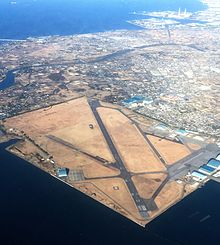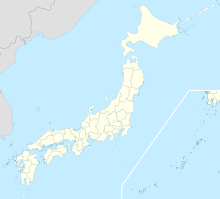Kisarazu Air Field

 Clash Royale CLAN TAG#URR8PPP
Clash Royale CLAN TAG#URR8PPP Kisarazu Air Field 木更津飛行場 Kisarazu Hikōjō | |||||||||||
|---|---|---|---|---|---|---|---|---|---|---|---|
 | |||||||||||
| |||||||||||
| Summary | |||||||||||
| Airport type | Military | ||||||||||
| Operator | |||||||||||
| Location | Kisarazu, Japan | ||||||||||
| Elevation AMSL | 10 ft / 3 m | ||||||||||
| Coordinates | 35°23′42″N 139°54′47″E / 35.39500°N 139.91306°E / 35.39500; 139.91306Coordinates: 35°23′42″N 139°54′47″E / 35.39500°N 139.91306°E / 35.39500; 139.91306 | ||||||||||
| Website | JGSDF 1st Helicopter Brigade | ||||||||||
| Map | |||||||||||
 RJTK Location in Japan | |||||||||||
Runways | |||||||||||
| |||||||||||
Source: Japanese AIP at AIS Japan[1] | |||||||||||
Kisarazu Air Field (木更津飛行場, Kisarazu Hikōjō) (ICAO: RJTK) is a military aerodrome of the Japan Ground Self-Defense Force JGSDF Camp Kisarazu (木更津駐屯地, Kisarazu Chūtonchi). It is located 1.2 NM (2.2 km; 1.4 mi) north northwest[1] of Kisarazu in the Chiba Prefecture, Japan.
Contents
1 Operations
2 History
2.1 Establishment and World War II
2.2 Postwar period
2.3 Osprey maintenance hub
3 References
Operations
JGSDF Kisarazu is home to the JGSDF 1st Helicopter Brigade, which is attached to the Central Readiness Force.[2] operating as a supporting unit for the 1st Airborne Brigade and the Japanese Special Forces Group.[3] The base also supports tenant units from the Japan Maritime Self-Defense Force and Japan Air Self-Defence Force
History
Establishment and World War II
Kisarazu Air Field was originally established in 1936 as a base for the Imperial Japanese Navy Air Service, subordinate to the Yokosuka Naval District. It was home to the Kisarazu Air Group, the Imperial Japanese Navy's first dedicated land-based bomber unit, which saw extensive combat during the Second Sino-Japanese War and World War II. The base was also used for training, and the testing of experimental aircraft, including Japan's first jet-powered aircraft, the Nakajima Kikka.
Postwar period
After the end of World War II, from September 1945 the base was used by the United States Air Force as "Kisarazu Air Base". In 1956, the base was officially transferred to the control of the Japan Air Self-Defense Force (JASDF) and was used as a training base; although USAF units remained on the base in a tenant capacity until transferred to Tachikawa Air Base in 1961. Subsequently, American assets at Kisarazu came under the control of the United States Navy. In 1968, the JASDF relocated to Iruma Air Base, and Kisarazu was transferred to the control of the Japan Ground Self-Defense Force.
Remaining United States Navy assets were transferred to United States Fleet Activities Yokosuka from 1975, and there is currently no American presence at Kisarazu; however, under the terms of the Treaty of Mutual Cooperation and Security between the United States and Japan, Kisarazu Air Field remains available for use by aircraft of the United States 7th Fleet under the name "Kisarazu Auxiliary Landing Field".
Osprey maintenance hub
In 2014 the Japanese government publicly offered the base as a site for a maintenance hub for maintenance of V-22 Osprey tiltrotor aircraft operated by the United States Marine Corps from MCAS Futenma in Okinawa. The aircraft require maintenance every six years but the Futenma base lacks the facilities to do it.[4][5]
The JGSDF will also be acquiring Ospreys which will be maintained at the facility. Fuji Heavy Industries (FHI) will conduct the maintenance. FHI engineers had their first chance to see Ospreys at Naval Air Facility Atsugi in April 2016.[6] Noise level tests were conducted at Kisarazu in October 2016, comparing the Osprey noise to that of a CH-47 Chinook.[7] There was some opposition from local residents.[8] Maintenance of the aircraft was to begin from 2017.[9] An opening ceremony was held on January 12, 2017.[10]
References
^ ab AIS Japan Archived 2016-05-17 at the Portuguese Web Archive
^ [site=http://www.mod.go.jp/gsdf/crf/pa/organization.html site=http://www.mod.go.jp/gsdf/crf/pa/organization.html] Check|url=value (help). Retrieved May 13, 2017. Missing or empty|title=(help)[dead link]
^ "What is the CRF (Central Readiness Force)?". Archived from the original on 2014-05-14. Retrieved 2009-01-13.
^ "米軍オスプレイ整備、木更津駐屯地で 防衛省方針". Nihon Keizai Shimbun. 3 September 2014. Retrieved 3 September 2014. (in Japanese)
^ Japan to offer base in Chiba as U.S. Osprey maintenance depot Oct 22, 2014 Japan Times Retrieved November 14, 2016
^ Aircraft Maintainers Demonstrate MV-22B Osprey Systems at Atsugi April 23, 2016 DVIDS Retrieved November 14, 2016
^ Osprey noise levels measured at GSDF’s Kisarazu camp in Chiba Prefecture October 25, 2016 Japan Times Retrieved November 14, 2016
^ Construction of Osprey maintenance site underway in coastal area of Tokyo Bay March 16-22 2016 Japan Press Weekly Retrieved November 14, 2016
^ US Osprey aircraft come to SDF base in Kisarazu October 24, 2016 NHK World Retrieved November 14, 2016
^ MV-22 Osprey Depot-Level Repair Facility Opens in Japan January 13,2017 navy.mil Retrieved February 5, 2017